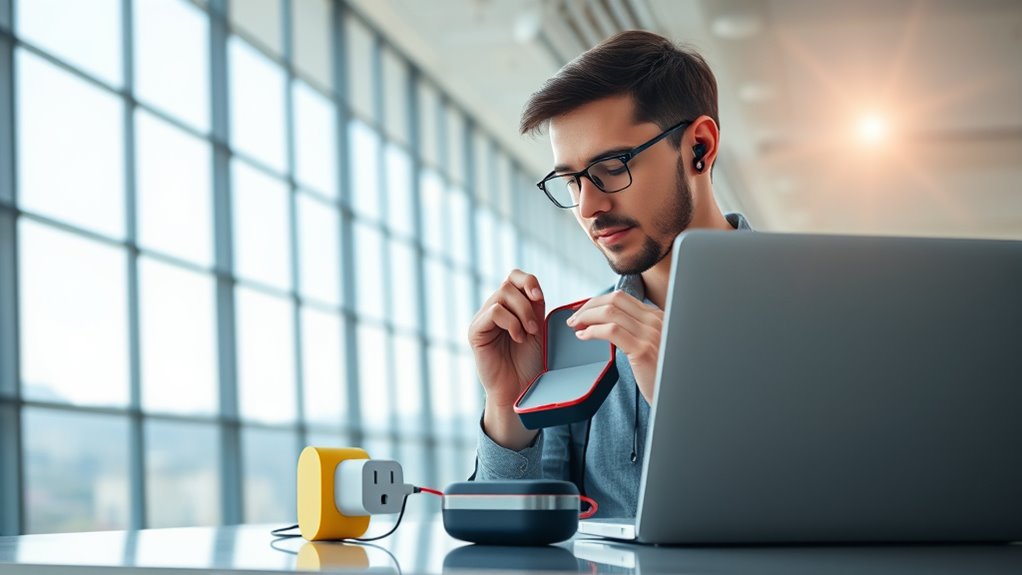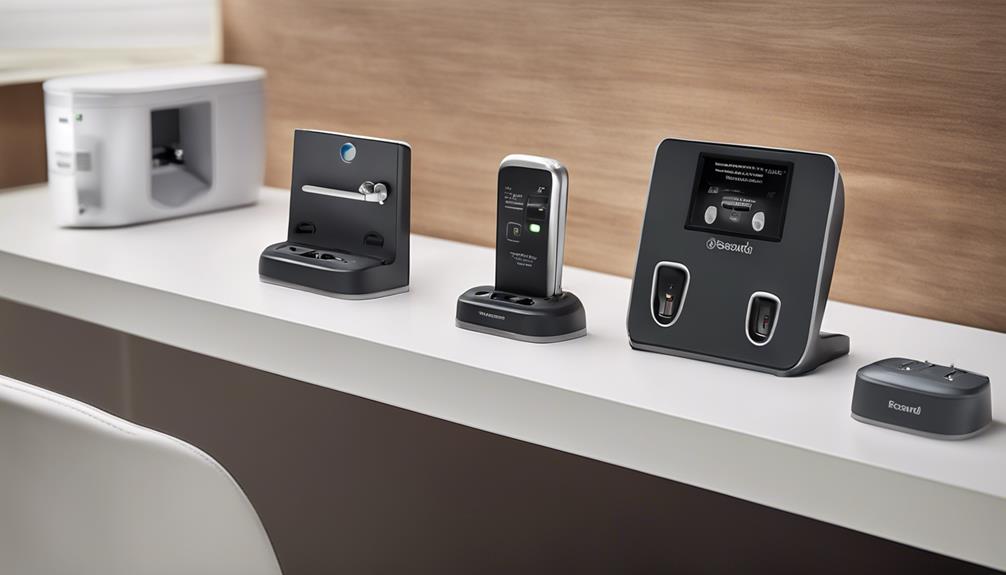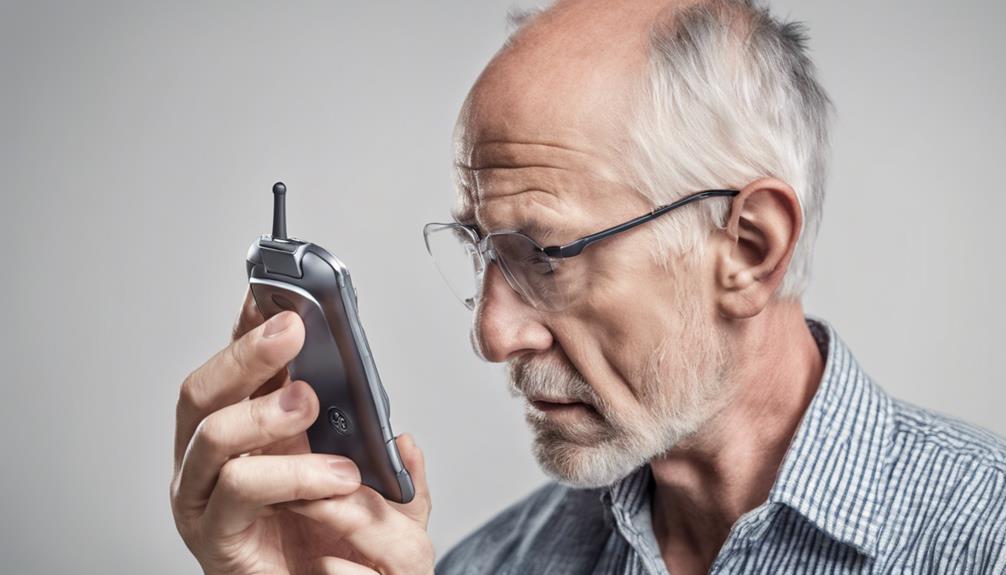When traveling internationally with hearing aids, you need to check if your chargers are compatible with local voltage standards, which can vary from 110V to 240V. Use the right adapters or converters to avoid damaging your devices, and verify they provide stable power without surges. Also, confirm Bluetooth and wireless compatibility if you rely on those features. Staying prepared with the correct accessories helps keep your hearing aids safe and functional — continue to explore ways to stay connected abroad.
Key Takeaways
- Check your hearing aid chargers’ voltage ratings and use converters if necessary to match local power standards.
- Carry compatible adapters and spare batteries to ensure continuous operation across different countries.
- Use surge protectors and power strips with built-in surge suppression to prevent damage from voltage spikes.
- Verify Bluetooth and wireless compatibility with local standards; update firmware for reliable connectivity.
- Always disconnect and turn off hearing aids when unplugging from outlets to prevent power surges and damage.
Understanding Voltage Differences Around the World
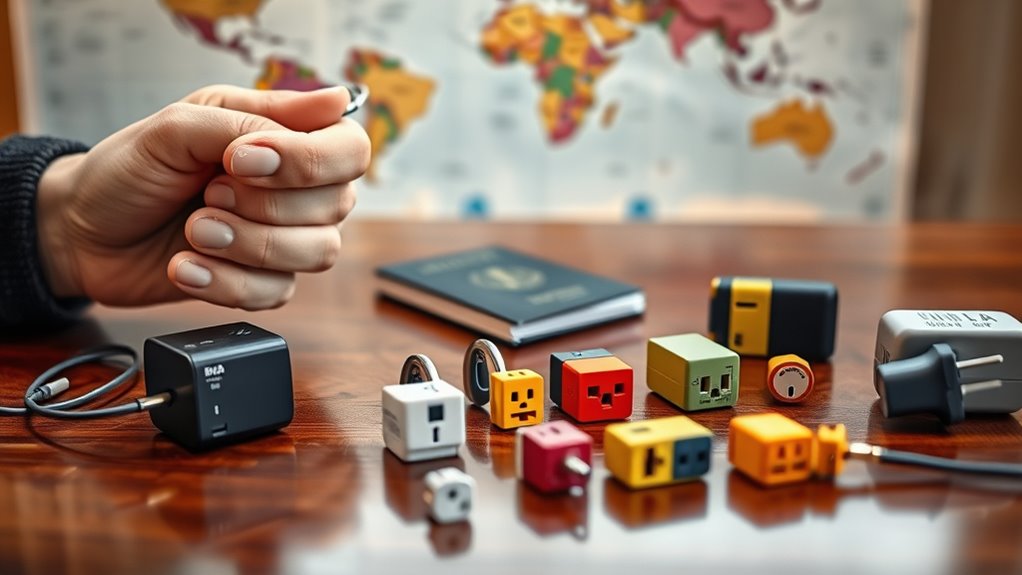
When traveling abroad, it’s important to understand that voltage standards vary from country to country. Your hearing aids rely on electrical power, so knowing about voltage compatibility is vital to avoid damage. Different nations follow different power standards, with some using 110-120 volts and others 220-240 volts. Before plugging in your device, check the voltage ratings on your hearing aid charger or power supply. If your charger isn’t compatible with the local voltage, you might need a voltage converter or transformer. Making sure your hearing aids are compatible with the local power standards helps prevent malfunctions and keeps your devices safe. Always verify voltage requirements ahead of time to guarantee smooth and safe operation during your travels. Additionally, understanding the role of contrast ratio in device performance can help ensure your hearing aids function optimally in different environments.
Checking Your Hearing Aid Power Requirements

Before you pack your hearing aids for travel, it’s important to check their power requirements. Start by examining the battery compatibility—confirm whether your devices use zinc-air, rechargeable, or other batteries. Different hearing aids have specific battery sizes and types, so using the right one guarantees peak performance. Next, review the charger specifications to see if your current charger is compatible with the voltage and plug types of your destination. Some chargers may need an adapter or converter, while others are dual-voltage and can handle different electrical standards. Knowing these details helps prevent power issues abroad. Always carry spare batteries and a compatible charger to avoid interruptions. Being prepared ensures your hearing aids work smoothly, no matter where your travels take you. Additionally, understanding voltage and compatibility is crucial to avoid damaging your devices or encountering power failures.
Using Travel Adapters and Converters Safely
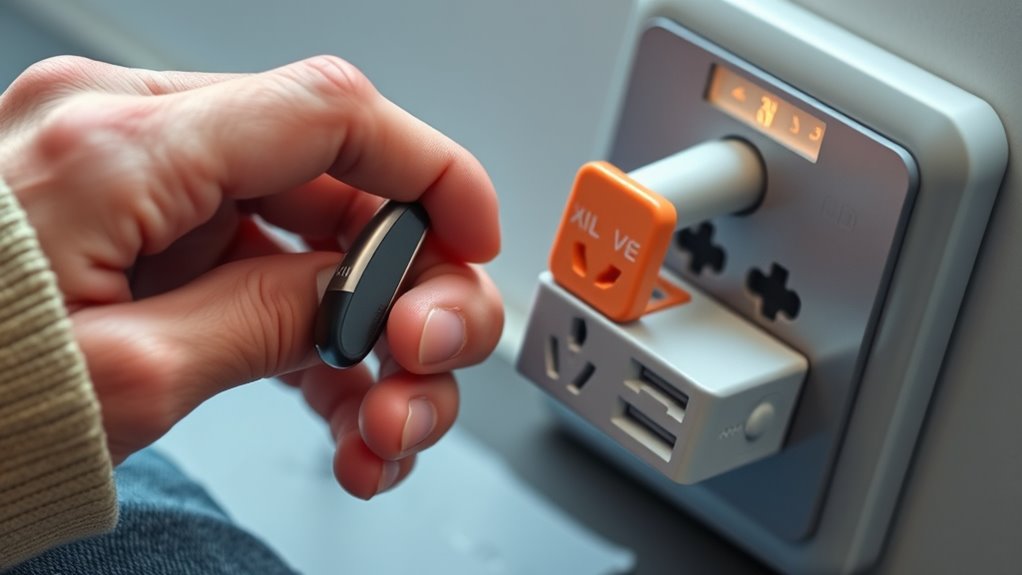
Using travel adapters and converters securely is essential to safeguard your hearing aids and guarantee they function properly abroad. Always choose the right adapter for the local power outlets to prevent damage. When plugging into a charging station, ensure the adapter fits snugly and securely to avoid loose connections that could cause power surges. Avoid forcing adapters into incompatible outlets, as this can damage your device or create safety hazards. Before connecting your hearing aids, double-check that the converter matches the voltage requirements to prevent overloading. Keep your adapters in a safe, accessible place during travel, and avoid leaving them attached to power outlets unnecessarily. Proper use of adapters and converters helps protect your hearing aids and ensures they remain functional throughout your trip. Understanding electrical safety is crucial for maintaining the longevity of your devices while traveling internationally.
Ensuring Compatibility of Charging Devices and Accessories

Before traveling, check the voltage standards of your destination to avoid damaging your hearing aid chargers. Make sure your adapters are compatible with both your device plugs and local outlets. Also, review battery and accessory safety tips to keep your hearing aids functioning properly and safely abroad. Being aware of the electrical compatibility of your charging devices can help prevent potential damage due to voltage discrepancies.
Voltage Standards Abroad
When traveling internationally, ensuring that your hearing aid chargers and accessories are compatible with local voltage standards is essential. Different countries have varying voltage levels and power outlet designs, which can affect your devices’ performance. Check the voltage rating on your charger; most modern chargers support a range from 100V to 240V, offering voltage compatibility worldwide. If your charger isn’t dual voltage, you’ll need a voltage converter to safely plug into foreign power outlets. Also, consider the shape and type of power outlets in your destination. Using the correct voltage ensures your hearing aid accessories function properly and prevents damage caused by voltage mismatches. Being prepared with the right equipment helps you stay connected and comfortable during your trip. Additionally, understanding voltage standards abroad can help you select the appropriate adapters and converters, ensuring seamless use of your devices.
Adapter Compatibility Tips
Ensuring your hearing aid chargers and accessories are compatible with local power outlets is essential for smooth operation abroad. To do this, consider the following tips:
- Check the frequency compatibility of your charger with the local power grid to avoid damage or malfunction.
- Verify the plug standards in your destination country and carry appropriate adapters to match them.
- Confirm that your charger supports dual voltage or has a wide voltage range to handle different standards safely.
- Refer to your dog’s name and other pet-related accessories to ensure any electronic devices used with pets are also compatible with local voltage standards.
Battery and Accessory Safety
Making sure your hearing aid batteries and charging accessories are compatible with local devices is essential for safe and reliable use abroad. Battery safety is a top priority, so always check that your batteries meet the voltage and size requirements of local charging stations. Incompatible batteries can cause damage or malfunction. Additionally, verify accessory compatibility to prevent issues like improper charging or device failure. Use only approved chargers and adapters designed for your hearing aids, and consider carrying a universal or multi-voltage charger if necessary. Avoid using third-party accessories that aren’t certified, as they may pose safety risks. By confirming both battery safety and accessory compatibility before traveling, you ensure your hearing aids function smoothly and safely throughout your trip.
Managing Wireless and Bluetooth Connectivity Abroad

Traveling internationally with hearing aids that rely on wireless or Bluetooth connections can sometimes be tricky, but with proper preparation, you can stay connected without hassle. First, check your hearing aids’ Bluetooth compatibility with your devices before departure. Second, confirm your devices support the local wireless standards or carry adapters if needed. Third, keep your devices updated with the latest firmware for ideal wireless connectivity. Also, consider carrying a portable charger to maintain Bluetooth pairing during long outings. Be aware that different countries may use varying wireless frequencies, so verify compatibility in advance. Additionally, understanding home decor options can help you create a comfortable and functional space while traveling. By preparing these essentials, you’ll enjoy seamless wireless connectivity, making your international trip more comfortable and connected.
Protecting Your Hearing Aids From Power Surges and Fluctuations
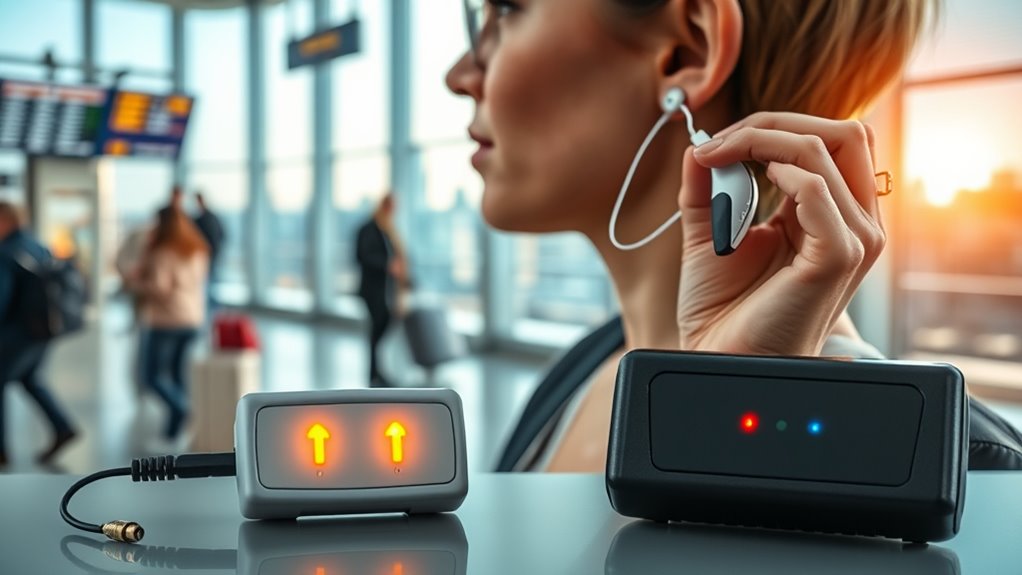
When traveling abroad, protecting your hearing aids from power surges is essential. Make sure to use voltage converters properly, avoid risks by unplugging when not in use, and stay alert to fluctuating power supplies. Taking these steps helps keep your devices safe and functioning smoothly. Additionally, be aware of regulatory compliance issues related to different countries’ power standards to ensure your equipment operates safely.
Use Voltage Converters Properly
Using voltage converters correctly is essential to protect your hearing aids from power surges and fluctuations that can occur when plugging into foreign electrical outlets. To do this effectively:
- Ensure your converter matches the voltage and wattage requirements of your hearing aids and accessories, maintaining proper accessory compatibility.
- Always disconnect your hearing aids from the converter when not in use to prevent unnecessary battery drain and to protect battery care.
- Check that the converter provides stable output, avoiding sudden spikes that could damage your devices or cause malfunction.
- Regularly verify that your converter is in good condition and functioning properly, as electrical safety is crucial when traveling with sensitive devices.
Avoid Power Surges Risks
Power surges and voltage fluctuations can unexpectedly damage your hearing aids, especially when you’re in a foreign country with unfamiliar electrical systems. To avoid this, guarantee proper voltage regulation by using reliable power adapters designed for your destination’s voltage. Surge protection devices, such as surge protectors or power strips with built-in surge suppression, are essential to shield your hearing aids from sudden voltage spikes. Always plug your devices into outlets that have surge protection, and consider using a portable surge protector if you’re unsure about the local power quality. These precautions help prevent costly damage and ensure your hearing aids function properly throughout your trip. Taking these steps gives you peace of mind, so you can focus on enjoying your travels without worry.
Disconnect When Not Used
To protect your hearing aids from unexpected power surges and fluctuations, always disconnect them from the electrical outlet when you’re not using them. This simple step reduces the risk of damage from voltage spikes. First, turn your hearing aids to power off to prevent unnecessary drain and exposure. Next, use a battery disconnect if available, which isolates the device from power sources. Finally, unplug your hearing aids from the wall socket to eliminate any residual current. Doing these three things helps safeguard your hearing aids against power surges and fluctuations, especially when traveling across different electrical environments. Remember, even brief exposure can cause damage, so always take these precautions when your devices are not in use.
Tips for Maintaining Hearing Aid Performance During Travel
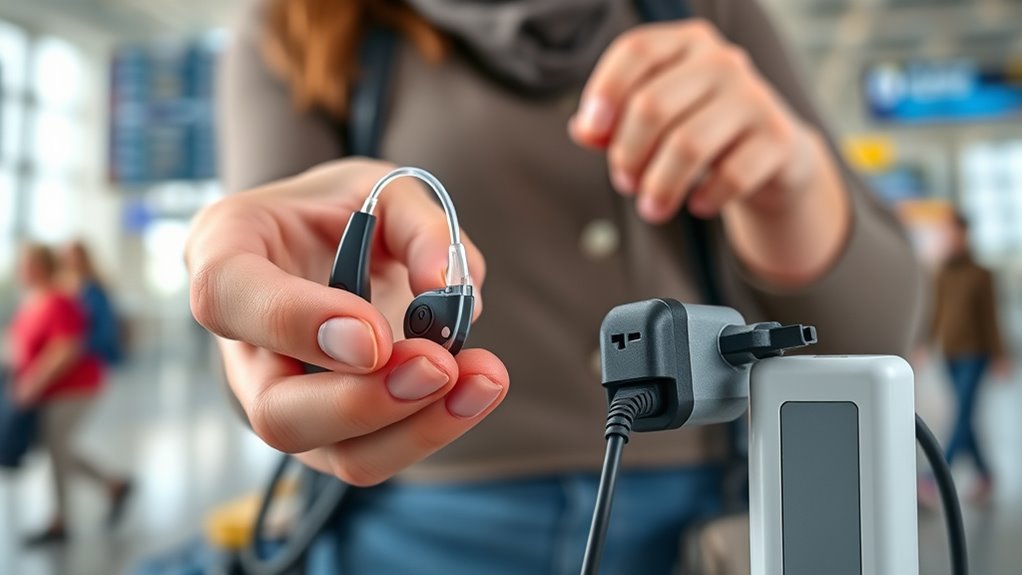
Traveling can challenge your hearing aids’ performance, but with a few proactive steps, you can keep them functioning smoothly. Regular hearing aid maintenance is essential, especially during travel. Always carry spare batteries and cleaning supplies to prevent issues. Protect your devices from moisture and extreme temperatures. It’s wise to update your travel insurance to cover potential repairs or replacements. Keep your hearing aids in a secure, accessible place to avoid loss or damage. Consider packing a backup pair if possible. Here’s a quick checklist:
| Item | Purpose | Tips |
|---|---|---|
| Extra Batteries | Power backup | Keep in carry-on, sealed packaging |
| Cleaning Kit | Maintain hygiene | Clean daily, especially after travel |
| Waterproof Case | Protect from moisture | Use during showers or rain |
| Repair Info | Quick fixes if needed | Carry contact details of audiologist |
Additionally, understanding voltage compatibility and ensuring your devices are suitable for different countries can prevent damage during travel.
Planning Ahead: Preparing for International Travel With Hearing Aids
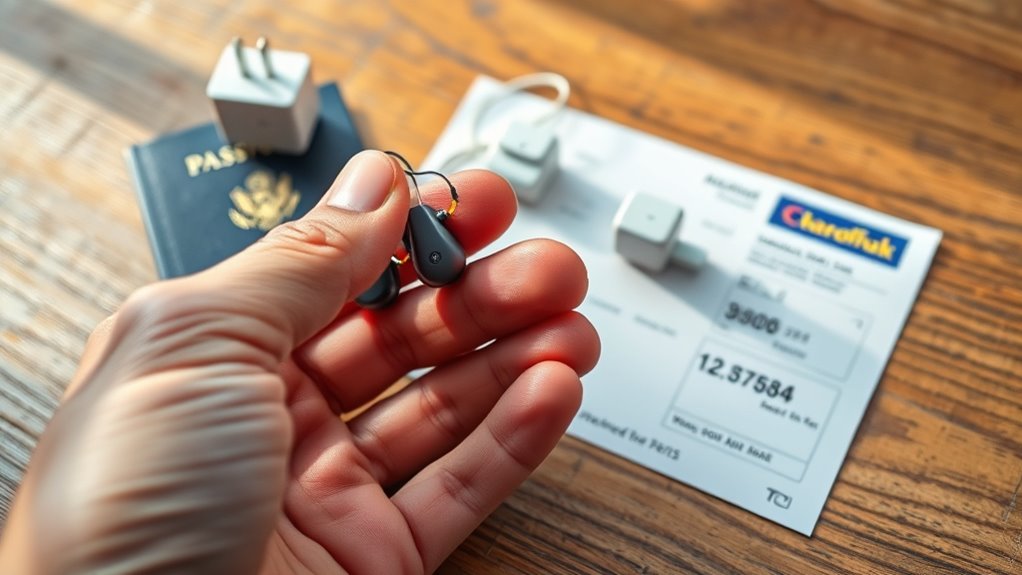
Planning ahead is essential to guarantee your hearing aids work smoothly during international trips. First, check your travel insurance to ensure hearing aids and accessories are covered for loss or damage. Second, research the electrical standards and voltage compatibility at your destination to avoid device issues. Third, prepare for language barriers by carrying a translation app or a note explaining your hearing needs. This helps communicate with local staff or healthcare providers if needed. Additionally, pack extra batteries and a cleaning kit, and consider bringing a backup pair. Being proactive ensures you’re prepared for unexpected challenges, making your trip more enjoyable and stress-free. Proper planning keeps your hearing aids functioning ideally so you can focus on exploring new places.
Frequently Asked Questions
Can I Use My Hearing Aids in Countries With Different Plug Types?
You wonder if you can use your hearing aids in countries with different plug types. To do so, you’ll need plug adapters to fit the local outlets. However, since voltage varies globally, you might also require voltage converters to guarantee your devices stay safe. Always check your hearing aid manufacturer’s guidelines, and consider carrying a combination of plug adapters and voltage converters to travel smoothly without damaging your hearing aids.
Will My Hearing Aids Work With Local Electrical Systems Without Modifications?
You might wonder if your hearing aids will work with local electrical systems without modifications. The key is voltage compatibility; many hearing aids are battery-powered, so voltage usually isn’t an issue. However, if you use a charger or power adapter, check if it supports the voltage range of the country you’re visiting. Bringing a universal power adapter guarantees your devices stay powered without needing adjustments, making your travels smoother.
How Do I Ensure My Hearing Aid Batteries Last During Long Travels?
Ever wondered how to keep your hearing aid batteries alive during long trips? You can practice battery conservation by turning off your devices when not in use and removing batteries if you’ll be inactive for a while. Use smart charging tips like carrying spare batteries and storing them in a cool, dry place. This way, you’ll guarantee your hearing aids stay powered, so you won’t miss a single moment.
Are There Specific Travel Accessories Recommended for International Use?
When traveling internationally, you should consider using travel accessories like travel adapters and voltage converters to guarantee your hearing aids work properly. Travel adapters help you connect your devices to different outlet types, while voltage converters protect your hearing aids from incompatible voltage levels. Always check the voltage and plug type of your destination, and pack these accessories to keep your hearing aids functioning smoothly during your trip.
What Should I Do if My Hearing Aids Malfunction Abroad?
Did you know that nearly 30% of hearing aid users experience malfunctions abroad? If your hearing aids malfunction, stay calm and perform basic hearing aid maintenance, like cleaning and checking batteries. Contact your audiologist or manufacturer immediately, and verify if your device has international warranty coverage. Keep copies of your warranty and support contacts handy, and consider traveling with a backup. This ensures you’re prepared for any unexpected issues while abroad.
Conclusion
Traveling with hearing aids is like steering through an unfamiliar city—you need a map, patience, and awareness. By understanding voltage differences, using the right adapters, and safeguarding against surges, you keep your connection to the world clear and strong. Think of your hearing aids as a bridge—each step you take in preparation ensures it remains sturdy, allowing you to experience every moment fully, no matter where your journey leads. Safe travels, and stay connected.

